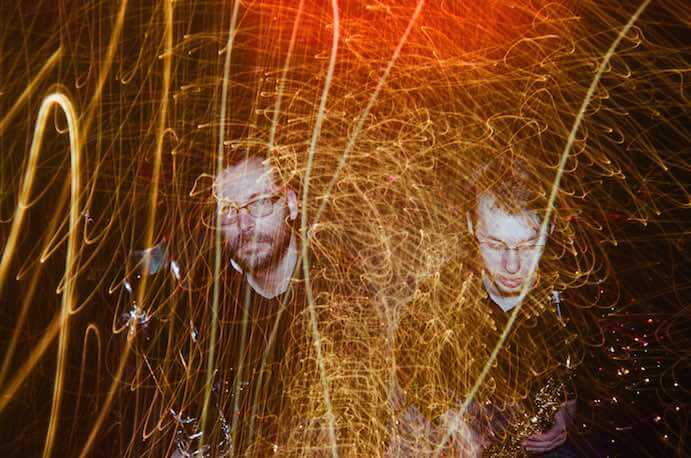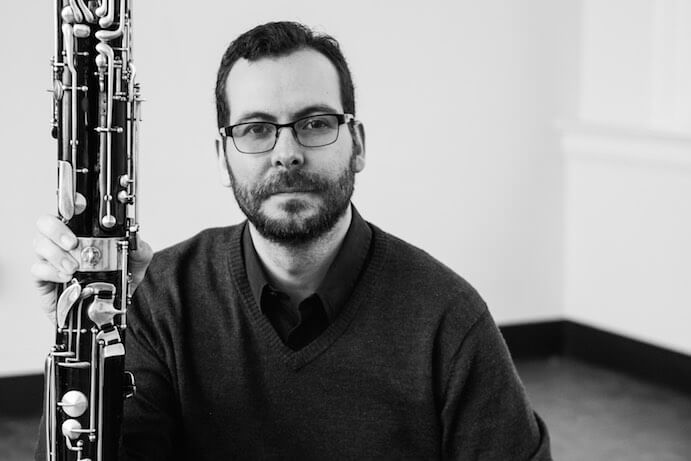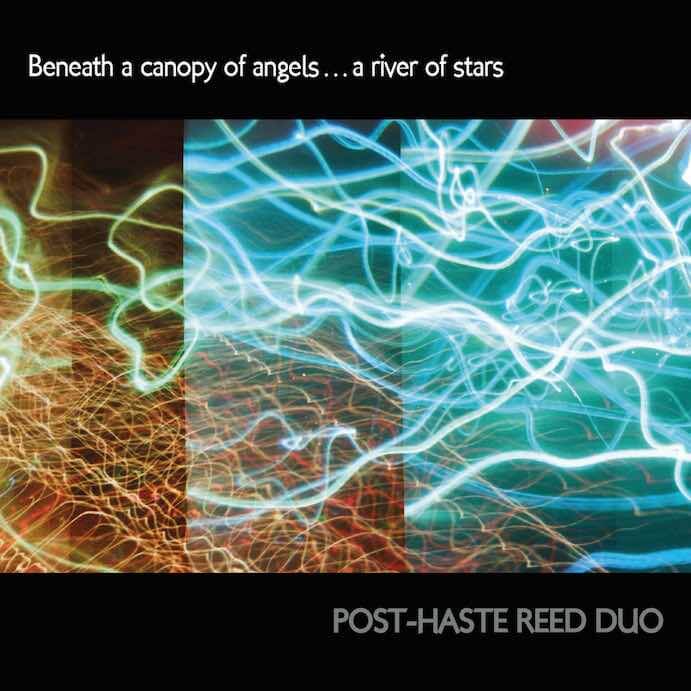We have all seen these commercials: the product representative hands a friend or even just a random person off the street a new product they are just not real sure about. But of course, just one taste or try and they are hooked. Same can be said about the Post-Haste Reed Duo’s debut album Beneath a canopy of angels… a River of Stars on Aerocade Music. Perhaps the unique combination of bassoon and saxophone evokes only thoughts of plaintive wailing in dark alleys or a sorcerer’s apprentice battling mop buckets–in reality, the combination works quite well, creating a highly listenable, inventive and engaging program, which vividly demonstrates how expressive and versatile these two instruments can be.
The five compositions on the album–each written for or arranged for the group–demonstrate Sean Fredenburg’s and Javier Rodriguez’s total command of their instruments, individually and collectively. Fredenburg’s array of saxophones can wail if needed but can also sing and propel the music rhythmically forward. Rodriguez’s versatility and virtuosity reminds you that the bassoon is related to the oboe and is equally lyrical and agile.
Simon Hutchinson‘s bioMechanics (2011) opens the album. One of the oldest and simplest natural sounds, that of a reed, combines with contemporary man-made electronics. Walls of mechanical electronic sound contrast, fuse, and clash with the earthly, organic reeds. Boldly propulsive, intensely lyrical, and juxtaposing controlled episodes with freely improvised passages, bioMechanics makes a bold and convincing opening statement packed into an exciting seven minutes.

Post-Haste Reed Duo
Louis Andriessen’s Lacrymosa (1991) is austerely lyrical and chilling, as befitting a work based on a line from the Latin “Dies Irae.” Originally for two bassoons, the arrangement by Jeff Chambers for bassoon and alto saxophone adds additional depth and emotion via the contrasting timbre of the sax. Compared with the two bassoon version, Chambers’ arrangement elevates the piece from a microtonal sound essay to a moving, organically lyrical essay on a “day of tears and mourning.” It is rare that an arrangement works better than the original, but Chambers and the virtuosity of the duo create a legitimate alternate interpretation of this intense, difficult work.
Ethan Wickman‘s Confluences (2014), inspired by aspects of astronomy and orbital mechanics, is a multi-movement exploration of tonal space, musical motifs, melodic elements, and the alto saxophone and bassoon’s shared yet frequently unique tonal qualities. In “Rogue,” each instrument spins its “song” on its own terms. Just as rogue planets refuse to conform to celestial mechanics, the alto sax and bassoon dart off in different directions as if they are trying to break free of each other. “Receding Orbits” develops a seven-note row for the saxophone based on a blending of the duo’s names: Javier and Sean. The bassoon enters with its own melodic line, and the two progress independently, becoming more agitated as the movement progresses. Finally, after an angry outburst, the instruments have a moment of unity until they drift off again. This winding, mesmerizing movement is one of the highlights of the album. “Beneath a canopy of angels… a river of stars” is an energetic and multifaceted scherzo based on sequences of patterns that explore and exploit the instruments’ range of tone color and expressive qualities. The duo alternately blend with each other and challenge each other, demonstrating the very essence of ensemble performance.

Javier Rodriguez
Lanier Sammons‘s Some thoughts about time (2012) consists of six short vignettes for alto/tenor saxophones and bassoon that can be performed in any order the performers choose. For the recording, Post-Haste Reed Duo and the composer chose to perform the work in the following order: “Stability,” “Intertwined,” “Strata,” “Bound,” “Held,” and “Patience.” This order creates an arch-like structure with the two middle movements “Strata” and “Bound” serving as the emotional and dramatic core, bookended with four contrasting, contemplative movements. “Stability” is a long unison chord that slowly goes “out of tune” only to slowly converge again. The subtle, microtonal changes of “Stability” dramatically and organically lead into the sinuous, fugue-like “Intertwined.” The agitated “Strata” and the intensely lyrical “Bound” reintroduce electronic sounds. The final piece, “Patience,” ends with rich organ tones in the electronics, but underlying is ambiguity… and “impatience” from the reeds. Since the movement order is indeterminate, listeners are encouraged to create different performances which expressing their own thoughts about time.

Sean Frendenburg
John Steinmetz explains that his four-part suite for soprano sax and bassoon, Songs and Dances (2013), “grew from things I love.” Echoes of a Bach aria, West African drum patterns, an American folksong, and high-energy pop music weave a lyrical, charming, and fascinating composition. Probably the most “conventional” work on the program, it, as do all the works, captures the impeccable ensemble work of the duo. Great fun!
Financed through a Kickstarter campaign, the Aerocade Music/Lanier Sammons produced CD is a first class professional effort with informative notes on each new work written by the composers. Mesmerizing, ear bending, lyrical, and engaging, Beneath a canopy of angels… a River of Stars is a stellar recording debut for Post-Haste Reed Duo and essential listening for those interested in contemporary chamber music.





















